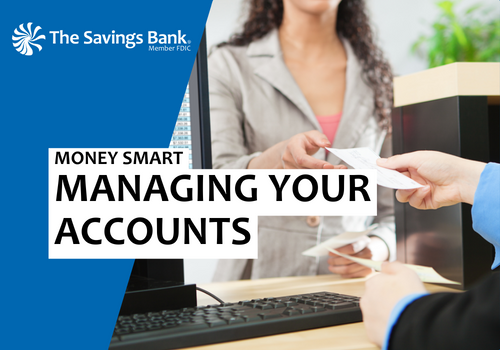Managing Your Accounts
04/25/2024

Managing Your Accounts
Checking and savings accounts are different by design. Knowing how to properly utilize and manage each can ensure you remain on the right track to achieving your financial goals!
Correctly managing your accounts is simple and straightforward – once you know the rules. A responsible account holder will keep track of their account usage and make sure they are following their bank’s policies. This helps the account holder keep costs down so they can continue to work towards their financial goals.
Checking accounts are the more complicated of the account types because they are designed to be used frequently. They are designed to process several transactions a day including:
- purchases,
- bill payments,
- money deposits,
- cash withdrawals,
- check writing.
The most important part of managing a checking account is making sure there are enough funds to cover all these transactions.
When you sign up for a checking account, you may receive a variety of products designed to help you use your account. This can include a debit card, ATM card, or checks. It is important to note a couple rules with each.
- Debit cards are NOT credit cards. The funds are not borrowed and are immediately debited from your account balance.
- ATM cards are usually only usable to withdraw money from ATM machines specifically designated by your bank. If you withdraw money from an out-of-network ATM, you may be subject to fees.
- Not all checking accounts use checks. If you need checks, make sure to speak to your account specialist when opening the account.
Perhaps the biggest thing to understand about your checking account is overdraft. An overdraft occurs when you do not have enough money in your account to cover a transaction. Banks can handle overdrafts different ways. Some banks made decisions on whether to pay or return an item on a case-by-case review and decision making. Other banks have automated overdraft programs, sometimes called overdraft protection or overdraft privilege. This is designed to let a transaction go through your account even if you do not have the funds to cover it. Not all banks or accounts offer overdraft services, and not all customers will be eligible. However, federal law requires you to be able to opt out of overdraft services. If you opt out, transactions with insufficient funds will be denied. Opting in means the bank will allow the transactions through, usually for a fee. Note that the fee is usually per transaction. The best way to learn about your financial institution’s overdraft policy is to ask! Some important questions might be:
- In what order do you process transactions?
- Will your overdraft service cover a check or bill payment overdraft, and what are the fees?
- What are the rules and fees for your overdraft service in general?
However, the best practice is to keep a close eye on your account to avoid an overdraft altogether. Checking your balance daily, or even several times a day, is a great habit to ensure you always know your balance.
Savings accounts require far less maintenance, as they are designed to set money aside for future use. Banks often limit the number of transactions that can come out of your savings account every month. If you exceed these limits, they may charge a fee. For this reason, it is discouraged to use your savings account to pay bills or daily expenses. However, most people will benefit from having a savings account. They usually earn interest on the money deposited, which will help you save for things like a car, house, or vacation. And you can deposit money as many times as you want!
Properly managing your accounts limits fees, ensures you are getting the most from your accounts, and helps you keep better track of your funds. Here at The Savings Bank we have many personal account options. If you would like to view our checking account options, click here: https://www.thesavingsbankohio.bank/personal/personal-checking. If you would like to view our savings account options, click here: https://www.thesavingsbankohio.bank/personal/personal-savings.
Sources:
https://playmoneysmart.fdic.gov/game/10

